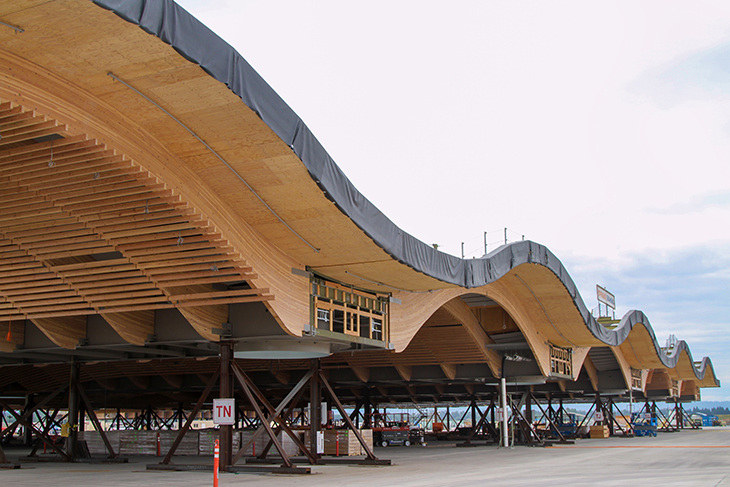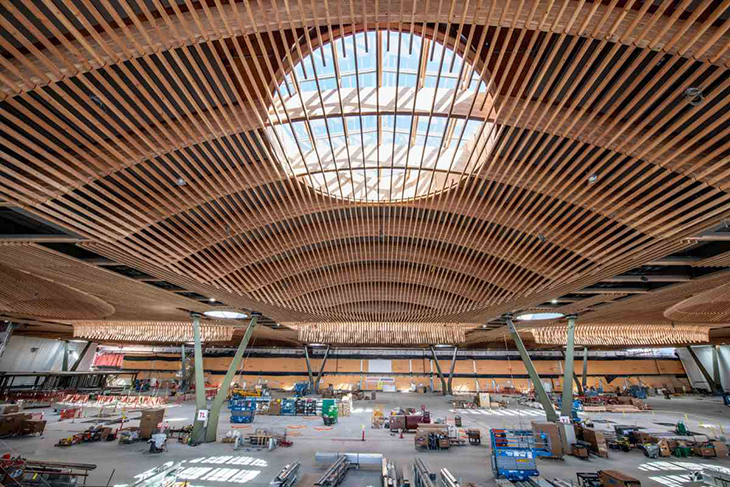
Oregon is renowned for its lush forests, and in a fitting tribute to its natural abundance, the upcoming terminal at the “Port of Portland” airport is set to be a groundbreaking example of innovation, primarily constructed from state-of-the-art timber.
At the forefront of this construction revolution is cross-laminated timber (CLT), often referred to as “mass-timber,” which is revolutionizing the field of architecture. This material boasts remarkable durability, impressive fire resistance, a minimal carbon footprint, and an aesthetically pleasing finish. Across Europe, CLT has even been employed to create towering skyscrapers affectionately termed “plyscrapers.”
Distinguishing itself from traditional plywood, CLT is crafted by pressing together long boards in a crosswise fashion, using glue and high temperatures to impart strength while maintaining flexibility.
The pièce de résistance of Portland’s new airport terminal is its immense atrium roof, spanning an impressive 9 acres. This expansive structure is being erected using CLT composed of Douglas fir, hemlock, and southern yellow pine, all sourced meticulously from within a 300-mile radius. Notably, these timber sources are exclusively from Oregon landowners and Tribal nations, underlining a commitment to local sustainability and community engagement.
“The process was so exacting, the architects knew every board that frames the skylights above the 26 Y-columns came from the Yakama Nation, and all the double beams in the six massive oval skylights came from the Coquille Indian Tribe,” wrote Patrick Sisson. He is from Fast Company.
“The Portland project has almost created a market across the country,” Dean Lewis said to the magazine. He is the director of mass timber and prefabrication for Skanska, the company behind the construction handling. “We’re getting calls from Atlanta and New York asking about the kinds of timber we can get within 300 miles of the city. ‘Can we do that here?’ They all want that local story.”

In addition to serving as a picturesque point for arrivals and departures, the terminal stands as a bold testament to the strength of the American mass timber market. This market, largely dominated by countries such as Sweden and Canada on the global stage, finds a notable showcase in the envisioned terminal.
Mass timber, despite the inevitable felling of trees, emerges as an environmentally conscious building solution with a low carbon footprint. In stark contrast, the production of concrete ranks among the top three contributors to greenhouse gas emissions worldwide. What sets mass timber apart is its inherent carbon sequestration process. By the time a tree reaches the optimal age for construction, the carbon it has absorbed over its lifespan becomes not only substantial but is also removed from the global carbon cycle when transformed into mass timber.
A compelling aspect of this sustainable approach is evident when considering the alternative fate of trees on conventional timber plantations. In scenarios where trees naturally perish, their decomposition results in the release of stored carbon back into the atmosphere. In contrast, the utilization of mass timber helps break this cycle, contributing to a more eco-friendly and carbon-neutral construction industry.
What are your thoughts? Please comment below and share this news!
True Activist / Report a typo


